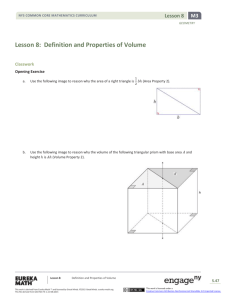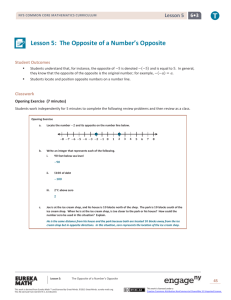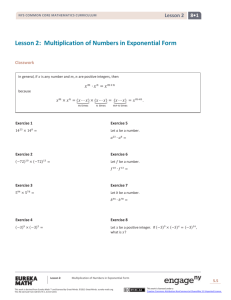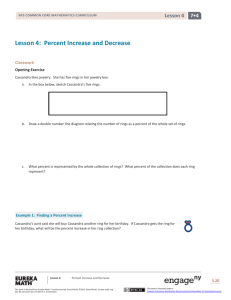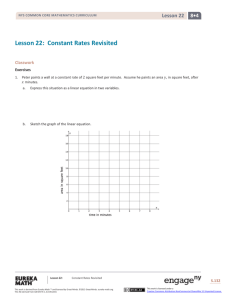Geometry Module 3, Topic A, Lesson 1: Student Version
advertisement
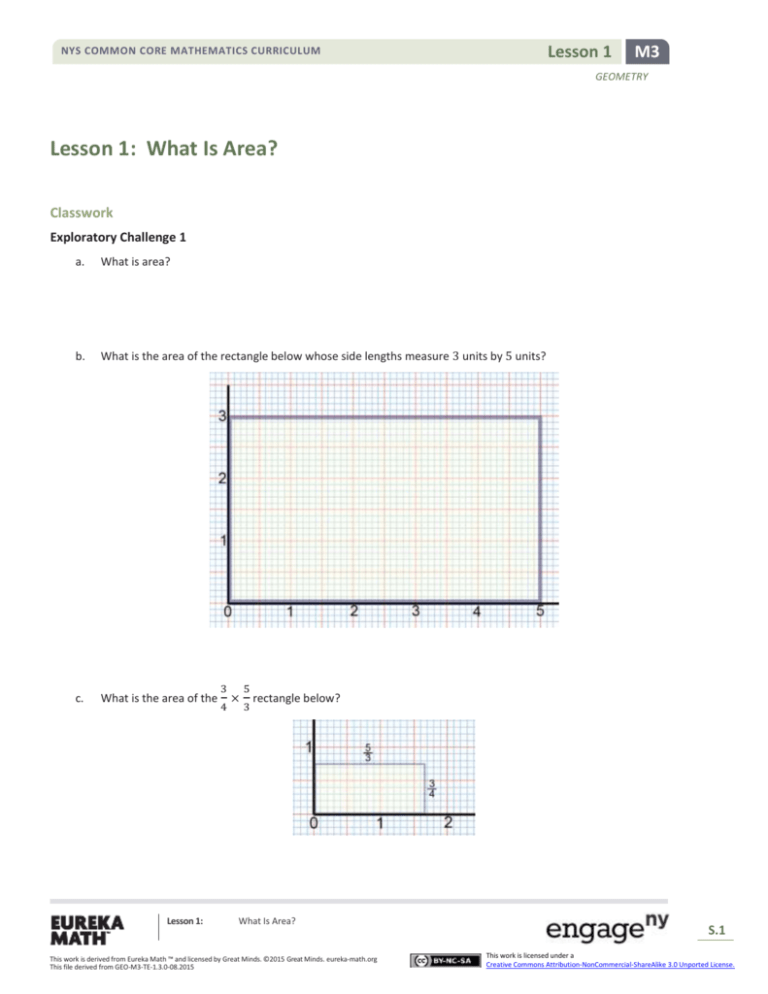
Lesson 1 NYS COMMON CORE MATHEMATICS CURRICULUM M3 GEOMETRY Lesson 1: What Is Area? Classwork Exploratory Challenge 1 a. What is area? b. What is the area of the rectangle below whose side lengths measure 3 units by 5 units? c. What is the area of the Lesson 1: 3 4 × 5 3 rectangle below? What Is Area? This work is derived from Eureka Math ™ and licensed by Great Minds. ©2015 Great Minds. eureka-math.org This file derived from GEO-M3-TE-1.3.0-08.2015 S.1 This work is licensed under a Creative Commons Attribution-NonCommercial-ShareAlike 3.0 Unported License. NYS COMMON CORE MATHEMATICS CURRICULUM Lesson 1 M3 GEOMETRY Exploratory Challenge 2 a. What is the area of the rectangle below whose side lengths measure √3 units by √2 units? Use the unit squares on the graph to guide your approximation. Explain how you determined your answer. b. Is your answer precise? Lesson 1: What Is Area? This work is derived from Eureka Math ™ and licensed by Great Minds. ©2015 Great Minds. eureka-math.org This file derived from GEO-M3-TE-1.3.0-08.2015 S.2 This work is licensed under a Creative Commons Attribution-NonCommercial-ShareAlike 3.0 Unported License. Lesson 1 NYS COMMON CORE MATHEMATICS CURRICULUM M3 GEOMETRY Discussion Use Figures 1, 2, and 3 to find upper and lower approximations of the given rectangle. Figure 1 Figure 2 Lesson 1: What Is Area? This work is derived from Eureka Math ™ and licensed by Great Minds. ©2015 Great Minds. eureka-math.org This file derived from GEO-M3-TE-1.3.0-08.2015 S.3 This work is licensed under a Creative Commons Attribution-NonCommercial-ShareAlike 3.0 Unported License. Lesson 1 NYS COMMON CORE MATHEMATICS CURRICULUM M3 GEOMETRY Figure 3 Lower Approximations Less than √2 Less than √3 1 1 Less than or equal to 𝐴 1×1= 1 1.7 × 1.7 = 1.41 1.41 × 1.414 1.732 1.4142 1.7320 = 1.414 × 1.732 = 1.4142 × 1.7320 = 2.449 344 = 2.449 482 430 5 1.414 213 1.732 050 Lesson 1: 1.414 213 × 1.732 050 = 2.449 487 626 65 What Is Area? This work is derived from Eureka Math ™ and licensed by Great Minds. ©2015 Great Minds. eureka-math.org This file derived from GEO-M3-TE-1.3.0-08.2015 S.4 This work is licensed under a Creative Commons Attribution-NonCommercial-ShareAlike 3.0 Unported License. Lesson 1 NYS COMMON CORE MATHEMATICS CURRICULUM M3 GEOMETRY Upper Approximations Greater than √2 Greater than √3 2 2 1.5 1.8 1.42 1.74 Greater than or equal to 𝐴 2×2= 4 1.5 × 1.8 = 1.42 × 1.74 = 2.4708 1.733 × 1.733 = 1.4143 1.7321 1.4143 × 1.7321 = 2.449 709 03 1.41422 1.73206 1.41422 × 1.73206 = 2.449 513 893 2 = 2.449 490 772 914 Discussion If it takes one can of paint to cover a unit square in the coordinate plane, how many cans of paint are needed to paint the region within the curved figure? Lesson 1: What Is Area? This work is derived from Eureka Math ™ and licensed by Great Minds. ©2015 Great Minds. eureka-math.org This file derived from GEO-M3-TE-1.3.0-08.2015 S.5 This work is licensed under a Creative Commons Attribution-NonCommercial-ShareAlike 3.0 Unported License. Lesson 1 NYS COMMON CORE MATHEMATICS CURRICULUM M3 GEOMETRY Problem Set 15 1 4 is the same as 1 . 1. Use the following picture to explain why 2. Figures 1 and 2 below show two polygonal regions used to approximate the area of the region inside an ellipse and above the 𝑥-axis. 12 Figure 1 3. Figure 2 a. Which polygonal region has a greater area? Explain your reasoning. b. Which, if either, of the polygonal regions do you believe is closer in area to the region inside the ellipse and above the 𝑥-axis? Figures 1 and 2 below show two polygonal regions used to approximate the area of the region inside a parabola and above the 𝑥-axis. a. Use the shaded polygonal region in Figure 1 to give a lower estimate of the area 𝑎 under the curve and above the 𝑥-axis. b. Use the shaded polygonal region to give an upper estimate of the area 𝑎 under the curve and above the 𝑥-axis. c. Use (a) and (b) to give an average estimate of the area 𝑎. Lesson 1: What Is Area? This work is derived from Eureka Math ™ and licensed by Great Minds. ©2015 Great Minds. eureka-math.org This file derived from GEO-M3-TE-1.3.0-08.2015 S.6 This work is licensed under a Creative Commons Attribution-NonCommercial-ShareAlike 3.0 Unported License. NYS COMMON CORE MATHEMATICS CURRICULUM Lesson 1 M3 GEOMETRY 4. Problem 4 is an extension of Problem 3. Using the diagram, draw grid lines to represent each 1 2 unit. a. What do the new grid lines divide each unit square into? b. Use the squares described in part (a) to determine a lower estimate of area 𝑎 in the diagram. c. Use the squares described in part (a) to determine an upper estimate of area 𝑎 in the diagram. d. Calculate an average estimate of the area under the curve and above the 𝑥-axis based on your upper and lower estimates in parts (b) and (c). e. Do you think your average estimate in Problem 4 is more or less precise than your estimate from Problem 3? Explain. Lesson 1: What Is Area? This work is derived from Eureka Math ™ and licensed by Great Minds. ©2015 Great Minds. eureka-math.org This file derived from GEO-M3-TE-1.3.0-08.2015 S.7 This work is licensed under a Creative Commons Attribution-NonCommercial-ShareAlike 3.0 Unported License.





